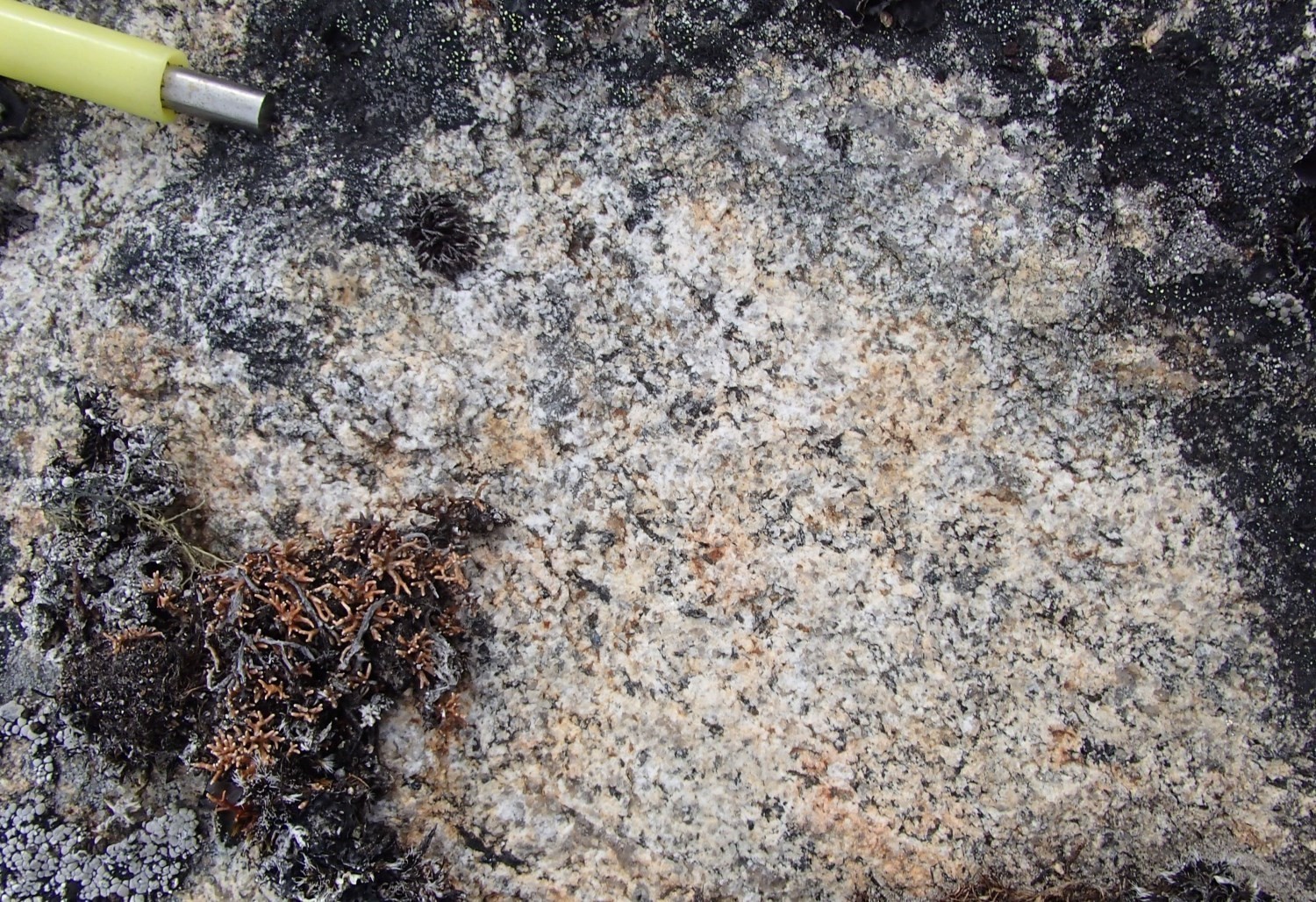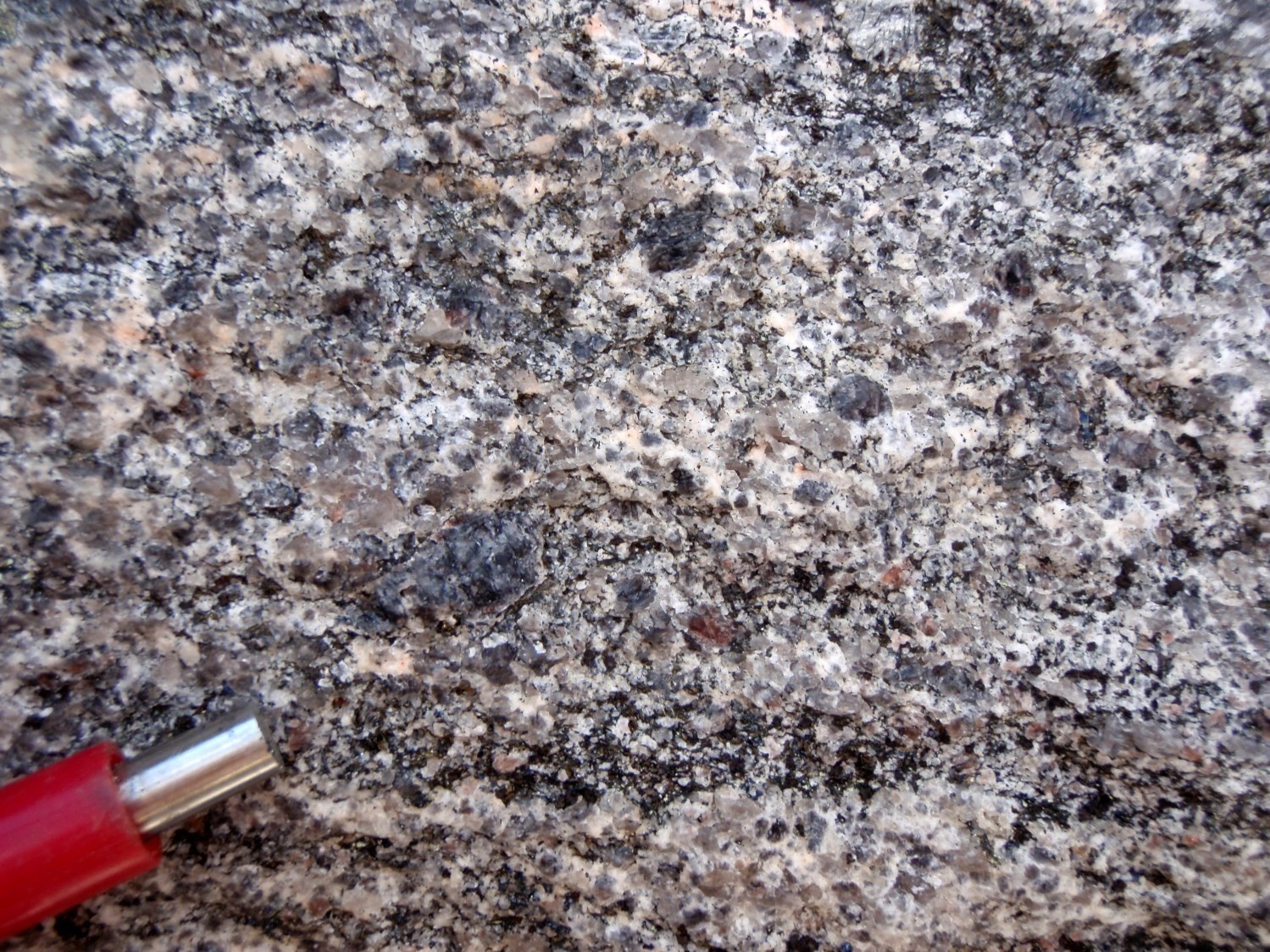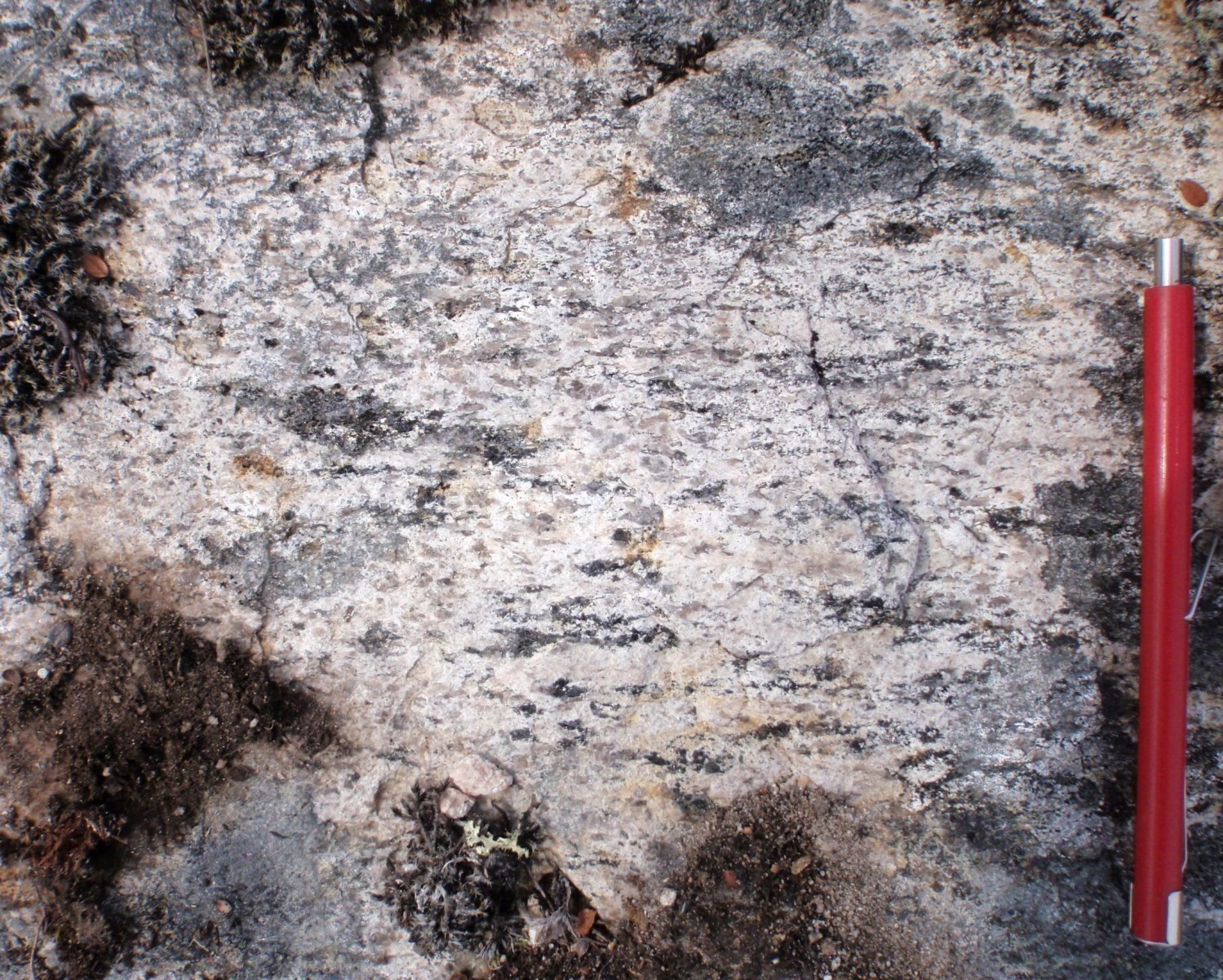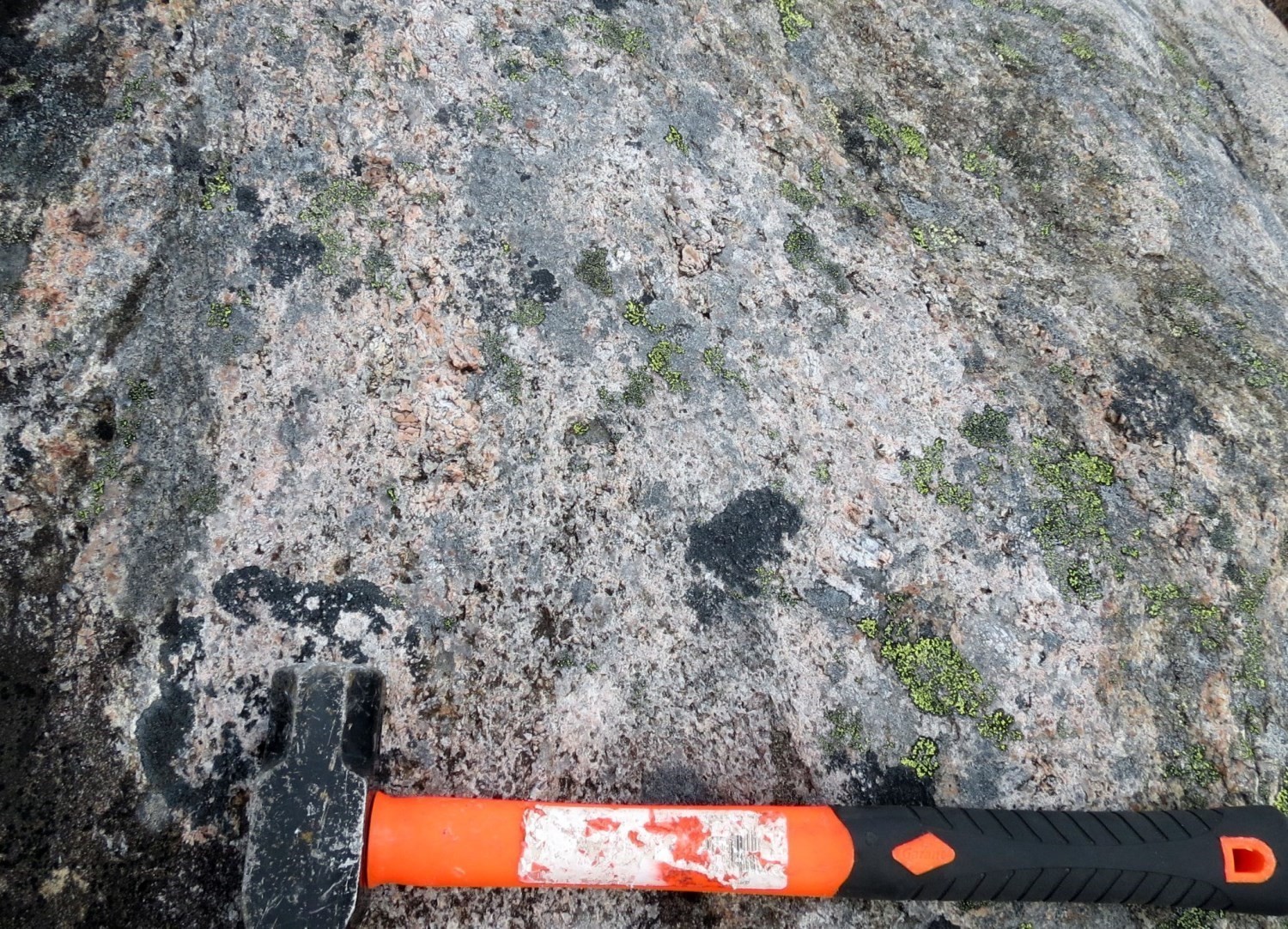
DISCLAIMER: This English version is translated from the original French. In case of any discrepancy, the French version shall prevail.
| Author(s): | Lafrance et al., 2015 |
| Age: | Neoarchean; Paleoproterozoic |
| Stratotype: | None |
| Type area: | Henrietta Lake area (NTS sheet 24H) |
| Geological province: | Churchill Province |
| Geological subdivision: | Falcoz Lithotectonic Domain |
| Lithology: | Charnockite |
| Category: | Lithodemic |
| Rank: | Suite |
| Status: | Formal |
| Use: | Acive |
None
Background
The Inuluttalik Suite was introduced by Lafrance et al. (2015) in the Henrietta Lake area to group hypersthene intrusive rocks observed in the western portion of the Torngat Orogen. The unit extends southward in the Brisson Lake area (Lafrance et al., 2016) and northward in the Koroc River and Point Le Droit areas (Mathieu et al., 2018).
As part of a regional synthesis of the southeastern Churchill Province (SECP; Lafrance et al., 2018), Lafrance and Vanier (2022) reassigned the quartz syenite to the Qarliik Suite (pPqik4) and the porphyroclastic monzogranite to the Baudan Suite (nAban1). Some subunits have also been upgraded to unit status. Finally, the age of the unit has also been modified by these authors. The table below summarizes the equivalences between the current and previous units.
|
Revised Units and Subunits (Lafrance and Vanier, 2022) |
Previous Units and Subunits |
References |
|
nApPina1 |
pPina1 |
Lafrance et al., 2015 and 2016; Mathieu et al., 2018 |
|
nApPina1a |
pPina1a |
|
|
nApPina2 |
pPina2 |
|
|
nApPina2a |
pPina2a |
Mathieu et al., 2018 |
|
nApPina3 |
pPina2c |
|
|
nAban1 |
pPina2b |
|
|
pPqik4 |
pPina2d |
Description
The Inuluttalik Suite commonly contains 5 to 15% centimetric to decimetric enclaves and layers of hypersthene tonalitic orthogneiss of the Sukaliuk Complex and Nuvulialuk Suite mafic rocks (pPnuv). It appears to consist of several felsic intrusive phases that cut each other; these numerous intrusions give a diffuse banding appearance to outcrops locally. Magnetism of these rocks is variable, ranging from very weak to strong. The Inuluttalik Suite consists of three units: 1) an enderbite unit; 2) a charnockite and opdalite unit; and 3) a pegmatitic granite and charnockite unit.
Inuluttalik Suite 1 (nApPina1): Enderbite
 Unit pPina1 consists predominantly of enderbite but also contains a small proportion of hypersthene quartz diorite. It is characterized by medium to coarse grain size, a greenish grey fresh surface, locally brown sugar, and a massive to weakly foliated texture. However, subhorizontal stretching lineation is widespread and manifests itself in the formation of quartz rods with undulatory extinction. There are other more coarse-grained intrusions ranging in composition from enderbite to charnockite to granite. These intrusions usually occur as more or less diffuse centimetric bands. In thin section, well-preserved, igneous textures are observed with the beginning of recrystallization at grain edges. Enderbite contains 18-30% quartz, <5% K-feldspar, interstitial or as exsolution in plagioclase, and 3-13% ferromagnesian minerals. These are mainly represented by hypersthene, biotite in small brown to red flakes, clinopyroxene and, more locally, hornblende. These ferromagnesian minerals usually form long, discontinuous clusters that look like schlieren. Orthopyroxene is commonly disaggregated and serpentinized (iddingsite). The main accessory minerals observed are apatite, opaque minerals (magnetite), epidote, zircon and carbonates.
Unit pPina1 consists predominantly of enderbite but also contains a small proportion of hypersthene quartz diorite. It is characterized by medium to coarse grain size, a greenish grey fresh surface, locally brown sugar, and a massive to weakly foliated texture. However, subhorizontal stretching lineation is widespread and manifests itself in the formation of quartz rods with undulatory extinction. There are other more coarse-grained intrusions ranging in composition from enderbite to charnockite to granite. These intrusions usually occur as more or less diffuse centimetric bands. In thin section, well-preserved, igneous textures are observed with the beginning of recrystallization at grain edges. Enderbite contains 18-30% quartz, <5% K-feldspar, interstitial or as exsolution in plagioclase, and 3-13% ferromagnesian minerals. These are mainly represented by hypersthene, biotite in small brown to red flakes, clinopyroxene and, more locally, hornblende. These ferromagnesian minerals usually form long, discontinuous clusters that look like schlieren. Orthopyroxene is commonly disaggregated and serpentinized (iddingsite). The main accessory minerals observed are apatite, opaque minerals (magnetite), epidote, zircon and carbonates.
Inuluttalik Suite 1a (nApPina1a): Purple Tonalite
 Locally, the orthopyroxene in the enderbite is retrograded to an assemblage of serpentine, amphibole and chlorite. These tonalites, assigned to subunit nApPina1a, are purplish and contain very dark quartz and burgundy plagioclase. Other mineral and structural characteristics are similar to the nApPina1 enderbite.
Locally, the orthopyroxene in the enderbite is retrograded to an assemblage of serpentine, amphibole and chlorite. These tonalites, assigned to subunit nApPina1a, are purplish and contain very dark quartz and burgundy plagioclase. Other mineral and structural characteristics are similar to the nApPina1 enderbite.
Inuluttalik Suite 2 (nApPina2): Charnockite and Opdalite
 In addition to forming kilometric intrusive masses, rocks of unit nApPina2 also occur as millimetric to decimetric intrusions, pink or brown sugar in the pPina1 enderbite and in orthogneisses of the Sukaliuk Complex. In outcrop, the rock is easily confused with the brown sugar-coloured phases of the nApPina1 enderbite. However, it contains 20 to 45% K-feldspar, which is generally not twinned in thin section. Charnockite commonly shows an unequal distribution of minerals that tend to form monomineralic centimetric clusters. It contains 20 to 25% quartz with strong undulatory extinction. Ferromagnesian minerals (8-20%) consist of brown to red biotite, orthopyroxene and hornblende with local clinopyroxene. Orthopyroxene is replaced to varying degrees by hornblende or iddingsite. The rock is partially recrystallized along grain edges. The main accessory minerals are opaque minerals, apatite, zircon, sphene, epidote and allanite.
In addition to forming kilometric intrusive masses, rocks of unit nApPina2 also occur as millimetric to decimetric intrusions, pink or brown sugar in the pPina1 enderbite and in orthogneisses of the Sukaliuk Complex. In outcrop, the rock is easily confused with the brown sugar-coloured phases of the nApPina1 enderbite. However, it contains 20 to 45% K-feldspar, which is generally not twinned in thin section. Charnockite commonly shows an unequal distribution of minerals that tend to form monomineralic centimetric clusters. It contains 20 to 25% quartz with strong undulatory extinction. Ferromagnesian minerals (8-20%) consist of brown to red biotite, orthopyroxene and hornblende with local clinopyroxene. Orthopyroxene is replaced to varying degrees by hornblende or iddingsite. The rock is partially recrystallized along grain edges. The main accessory minerals are opaque minerals, apatite, zircon, sphene, epidote and allanite.
Inuluttalik Suite 2a (nApPina2a): Granite and Granodiorite
 Like the nApPina1 enderbite unit, charnockite and opdalite are locally retrograded to the amphibolite facies. These intrusive rocks are homogeneous, medium grained and light to medium pink. They are foliated and show lineations, locally protomylonitic on the edge of shear zones. The main expression of deformation is the alignment of ferromagnesian minerals (5-12%) consisting of brown biotite and muscovite flakes. Smoky quartz (20-27%) forms large zones with undulatory extinction, lenticular in places. Plagioclase and microcline (15-50%) show partial recrystallization between grains. Subunit nApPina2a contains the same accessory minerals as unit nApPina2.
Like the nApPina1 enderbite unit, charnockite and opdalite are locally retrograded to the amphibolite facies. These intrusive rocks are homogeneous, medium grained and light to medium pink. They are foliated and show lineations, locally protomylonitic on the edge of shear zones. The main expression of deformation is the alignment of ferromagnesian minerals (5-12%) consisting of brown biotite and muscovite flakes. Smoky quartz (20-27%) forms large zones with undulatory extinction, lenticular in places. Plagioclase and microcline (15-50%) show partial recrystallization between grains. Subunit nApPina2a contains the same accessory minerals as unit nApPina2.
Inuluttalik Suite 3 (nApPina3): Pegmatitic Granite and Charnockite
 The majority of the outcrops locally consist of pegmatitic intrusive rocks that cut all the units of the Inuluttalik Suite. The rock is dark pink, leucocratic, massive or marked by the lineation. It contains between 2 and 5% ferromagnesian minerals (biotite ± hornblende ± hypersthene), ~25% quartz and a lesser amount of muscovite and magnetite.
The majority of the outcrops locally consist of pegmatitic intrusive rocks that cut all the units of the Inuluttalik Suite. The rock is dark pink, leucocratic, massive or marked by the lineation. It contains between 2 and 5% ferromagnesian minerals (biotite ± hornblende ± hypersthene), ~25% quartz and a lesser amount of muscovite and magnetite.
Thickness and Distribution
The Inuluttalik Suite forms elongated plutons parallel to the regional structural grain that intrude the orthogneisses of the Sukaliuk Complex and are located in the eastern part of the Falcoz Lithotectonic Domain. It covers a total area of ~2121 km2. The rocks of the nApPina1 (~1299 km2), nApPina1a (~386 km2) and nApPina2 (~325 km2) units and subunits form hectometric to decakilometric wide intrusions ranging in length from 1 km to nearly 100 km. The nApPina2a (~22 km2) and nApPina3 (~2 km2) units and subunits are much more constrained and have only been described in the Pointe Le Droit area (Mathieu et al., 2018).
Dating
Samples from outcrops 2013-DB-1000, 2014-IL-3108, 2013-BC-6179, and 2013-CB-5168 were isotopically dated. The abundance of Archean inherited ages, primarily between 2.8 Ga and 2.5 Ga, reflects the complexity of this suite and suggests a mixture between Archean and Paleoproterozoic components (Corrigan et al., 2018; Davis et al., 2018).
Paleoproterozoic ages between ~1864 Ma and ~1822 Ma correspond to metamorphism related to the Torngat Orogeny, which was maintained at the granulite facies over an extended period (1885-1810 Ma; Charette, 2016; Charette et al., 2021). Assuming that the Inuluttalik Suite is a product of partial melting of the Sukaliuk Complex orthogneisses, these ages could represent those of the crystallization of anatexis magmas.
With respect to the Neoarchean component, also recognized locally in the Sukaliuk Complex, it is difficult to determine whether it reflects the emplacement of a Neoarchean crust, as interpreted by Corrigan et al. (2018), or a period of remobilization of an older (~2.9 Ga to ~2.7 Ga) Neoarchean crust. Thus, there may have been more than one episode of migmatization. The younger metamorphic ages (1808 Ma and 1800 Ma) could be explained by the slow cooling episode related to exhumation estimated between 1810 Ma and 1730 Ma by Charette et al. (2021).
| Unit | Sample Number | Isotopic System | Mineral | Crystallization Age (Ma) | (+) | (-) | Inherited Age (Ma) | (+) | (-) | Metamorphic Age (Ma) | (+) | (-) | Reference(s) |
| nApPina2 | 2013-DB-1100A | U-Pb | Zircon | 1822 | 8 | 8 | 2617 | 11 | 11 | Davis et al., 2018 | |||
| nApPina1 | U-Pb | Zircon | 1863.9 | 8.5 | 8.5 | 2.79-2.0 Ga | David, 2019 | ||||||
| BC-6179-A13 | U-Pb | Zircon | 2661 | 9 | 9 | 2832 | 21 | 21 | 1808 | 86 | 86 |
Corrigan et al., 2018 |
|
| nApPina1a | 2013-CB-5168A | U-Pb | Zircon | 2650 | 2740 à 2500 | 1800 | Corrigan and McFarlane, personal comm., 2015 |
Stratigraphic Relationship(s)
The Inuluttalik Suite includes hypersthene felsic intrusive rocks that could represent evolved products of partial melting of orthogneisses of the Sukaliuk Complex (Lafrance et al., 2015; David, 2019). In fact, the rocks of the Inuluttalik Suite contain numerous orthogneiss enclaves, which could constitute rafts within a diatexite. In outcrop, the distinction between these two units is generally difficult due to the poor quality of the outcrops (lichen cover) and the great similarity between lithologies. The contact between the two units seems diffuse on a fresh surface. However, rock staining makes it possible to highlight the structural differences.
Charette (2016) mentioned that the lack of texture indicating partial melting in the Sukaliuk Complex could be linked to their destruction during high temperature deformation. The presence of coarse-grained leucocratic bands in gneiss, the close spatial association between the two units, and the presence of numerous biotite schlieren inside the intrusive rocks of the Inuluttalik Suite indicate that the Torngat orogenesis could represent a migmatization episode associated with the extraction and accumulation of anatectic liquids.
Paleontology
Does not apply.
References
Publications Available through SIGÉOM Examine
DAVID, J., 2019. Datations U-Pb dans les provinces du Supérieur et de Churchill effectuées au GEOTOP en 2014-2015. MERN, GEOTOP; MB 2019-03, 24 pages.
DAVIS, D. W., LAFRANCE, I., GOUTIER, J., BANDYAYERA, D., TALLA TAKAM, F., GIGON, J., 2018. Datations U-Pb dans les provinces de Churchill et du Supérieur effectuées au JSGL en 2013-2014. MERN; RP 2017-01, 63 pages.
LAFRANCE, I., BANDYAYERA, D., BILODEAU, C., 2015. GEOLOGIE DE LA REGION DU LAC HENRIETTA (SNRC 24H). MERN; RG 2015-01, 62 pages, 1 plan.
LAFRANCE, I., BANDYAYERA, D., CHARETTE, B., BILODEAU, C., DAVID, J., 2016. GEOLOGIE DE LA REGION DU LAC BRISSON (SNRC 24A). MERN; RG 2015-05, 64 pages, 1 plan.
LAFRANCE, I., CHARETTE, B., VANIER, M.-A., 2018. Sud-est de la Province de Churchill, Nunavik, Québec, Canada: synthèse de la géologie. MERN; BG 2018-12
LAFRANCE, I., VANIER, M.-A., 2022. Domaine lithotectonique de Falcoz, sud-est de la Province de Churchill, Nunavik, Québec, Canada : synthèse de la géologie. MERN; BG 2022-01, 2 plans.
MATHIEU, G., LAFRANCE, I., VANIER, M.-A., 2018. Géologie de la région de pointe Le Droit, Province de Nain et sud-est de la Province de Churchill, Nunavik, Québec, Canada. MERN; BG 2018-07, 4 plans.
Other Publications
CHARETTE, B., 2016. Long-lived Anatexis in the Exhumed Middle Crust from the Torngat Orogen and Eastern Core Zone: Constraints from Geochronology, Petrochronology, and Phase Equilibria Modeling. University of Waterloo; thèse de maîtrise, 389 pages. uwspace.uwaterloo.ca/handle/10012/10453
CHARETTE, B., GODET, A., GUILMETTE, C., DAVIS, D.W., VERVOORT, J., KENDALL, B., LAFRANCE, I., BANDYAYERA, D., YAKYMCHUK, C., 2021. Long-lived anatexis in the exhumed middle crust of the Torngat Orogen: Constraints from phase equilibria modeling and garnet, zircon, and monazite geochronology. Lithos; volume 388-389. doi.org/10.1016/j.lithos. 2021.106022
CORRIGAN, D., WODICKA, N., McFARLANE, C., LAFRANCE, I., VAN ROOYEN, D., BANDYAYERA, D., BILODEAU, C. 2018. Lithotectonic framework of the Core Zone, Southeastern Churchill Province. Geoscience Canada; volume 45, pages 1-24. doi.org/10.12789/geocanj.2018.45.128
Suggested Citation
Ministère de l’Énergie et des Ressources naturelles (MERN). Inuluttalik Suite. Lexique stratigraphique du Québec. https://gq.mines.gouv.qc.ca/lexique-stratigraphique/province-de-churchill/suite-inuluttalik_en [accessed on Day Month Year].
Contributors
|
First Publication |
Isabelle Lafrance, P. Geo., M.Sc. isabelle.lafrance@mern.gouv.qc.ca (redaction) Mehdi A. Guemache, P. Geo., Ph.D. (coordination); Claude Dion, Eng., M.Sc. (critical review and editing); Céline Dupuis, P. Geo., Ph.D. (English version); Caroline Thorn (HTML editing). |
|
Revision(s) |
Isabelle Lafrance, P. Geo., M.Sc. (redaction) Mehdi A. Guemache, P. Geo., Ph.D. (coordination); Marc-Antoine Vanier, Eng., M.Sc. (critical review); Simon Auclair, P. Geo., M.Sc. (editing); Dominique Richard, GIT, Ph.D. (English version); André Tremblay (HTML editing). |

